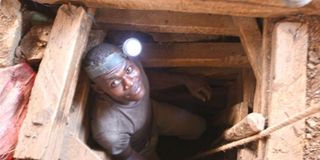Bullying, threats and bureaucracy that frustrate players in the mining sector

A mine in Nyatike, Migori County. President Kenyatta should urgently establish a credible independent task force to examine why the mining sector as a whole is failing to deliver towards his Big Four Agenda.
Robert Shaw: Bullying, threats and bureaucracy that frustrate players in the mining sector
We have taken one almighty battering this year. This has, in turn, made us go back to the drawing board and re-evaluate so many of our policies and practices.
We have had to do that as things will never be the same again. As well as cutting and scraping to get through, we need to see where we can change and get more value out of our fewer, dwindling and smaller opportunities.
In recent pieces, I’ve urged us to go through our economic drivers one by one, metaphorically take them apart, and see how we can put the remaining functioning parts of them back together so we get better performance and value.
I missed out by default on one very important economic driver, which has had its ups and downs, but has huge potential: mining. In short Kenya has a variety of mineral deposits throughout the country ranging from titanium to gold to soda ash to fluorspar. Much of the gold has been in the form of informal small-scale mining, but with the advent of new and better technology, some are very much viable, albeit in conjunction with that new technology.
But the history of mining in Kenya is a chequered one and also one that national and county governments take a fair portion of the blame. The Australian conglomerate Base Titanium in Kwale County has done much to transform this former economic backwater with its mining activity, direct and indirect employment creation, community health programmes complete with its many positive trickle down effects.
Foreign exchange earner
It has also become a significant foreign exchange earner in its own right. But it has not been without official harassment and plain intimidation.
There was a time, during Najib Balala’s tenure of the Mining portfolio that it had problems getting export clearance and tonnes and tonnes of its product was stuck.
This then resulted in the company reviewing its whole operation in Kenya, including a possible cutback of its investment plans. So bad is Kenya’s international rating when it comes to mining that it no longer rates in the Fraser Institute Investment Attractiveness Index to Mining. In 2017, it was number 90 out of 91. It dropped out of the index in 2018 and remains out of the index today.
One of the main reasons for this is that the 2016 Mining Act was a poor piece of legislation that is restrictive, over-regulatory and vulnerable to political and official arbitrariness. It also fails comprehensively to address the key issues of land ownership and consent to mine, which are fundamental to any mining project.
That is a stinging indictment against the country considering its wealth in minerals and explains why they largely remain untapped. It is in complete contrast to countries which have large mineral deposits and have geared their legislation, rules and regulations in a more proactive manner.
In short, they encourage and regulate, whereas Kenya discourages and regulates, often in an arbitrary manner. The same is happening in the country’s gold industry.
There is a potential of 15 to 20 formal small to mid-scale gold sites, yet only two legitimate commercial scale gold mining operations have been developed in the past two decades.
Western Kenya is rich in near-production gold assets, but most are relics of the past and a glaring example of a failed policy. Their reasons are not to do with inadequate reserves, but a complete lack of support from government often with official discouragement and coercion.
The two mines that remain, Kilimapesa-based near Lolgorian, which has seen its operations start and stop over the last 15 years, and Karebe in Nandi County, have been subject to continuous harassment from central and county governments as well as an array of officials and politicians.
The mine was closed for five months last year and 10 months this year as a result of questionable legal rulings associated with a concerted campaign to defraud its foreign investors and take over the mine with a Chinese partner.
Intrusive approach
In Nandi alone, there has been alleged interference from the Deputy President’s Office, the governor’s office as well as the Lands Department and numerous others. The Department of Mines and Geology, under Alfred Keter, has played along with, indeed overseen, this reactive and intrusive approach despite and in stark contrast to the government’s official policy of encouraging legitimate investment especially in needy areas such as Western.
In Kakamega County, Barrick Gold recently sold a +1 million ounce gold resource to Shanta Gold, a credible and well established operator from neighbouring Tanzania. Kenya’s largest gold mining opportunity is unlikely to see the light of day in this toxic environment.
President Kenyatta should urgently establish a credible independent task force to examine why the mining sector as a whole is failing to deliver towards his Big Four Agenda.
If he were to send an independent team to evaluate the potential of gold mining in Western Kenya in particular and examine what is being done to both encourage it and more importantly discourage it, he is likely to be shocked.





